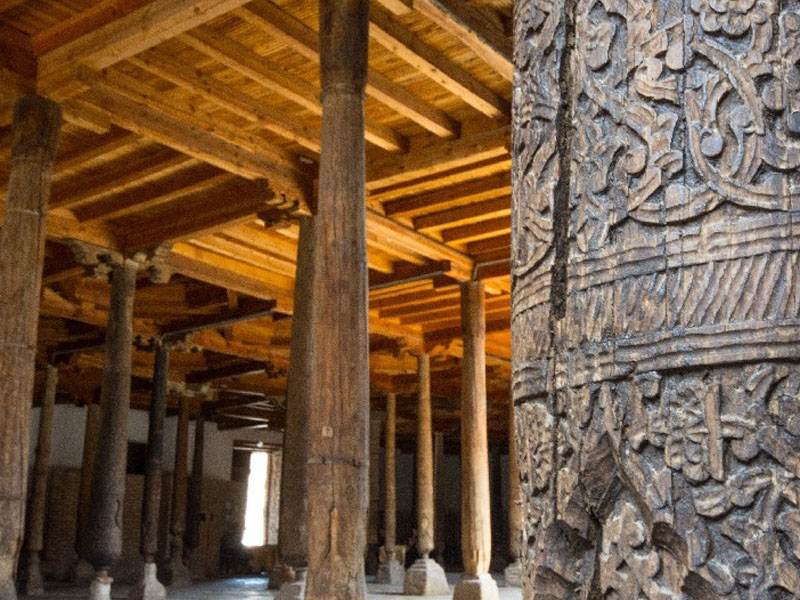



Attraction

Recreation

Ata Palvanov represented Khiva school of wood-carving; his creative age coincided with the verge of the two centuries. He was born in 1867 in Kiyot village in the family of a master wood-carver, and learned the secrets of the trade from his father Palvan urachi and his grandfather Abdusattar. Up until 1927 Ata Palvanov installed carved doors and columns for madrasahs and mosques, and residential buildings. In 1929, having joined the “Uchkun” traditional applied art co-operative, Palvanov worked together with his student Safo Boghibekov (1903-1978). They created compositionally unique, beautiful items decorated with aylanma islimi vegetable designs, which leave no one indifferent.
Pillared One of the columns ornamented in 1937 is now kept at the State Art Museum of Uzbekistan. This item was awarded Gold Medal at an international exhibition in Paris. The originality of the Khiva school of wood-carving is in the compositions that are perfect in terms of positioning of the designs that consist of smoothly intertwining stems, wave-like shoots with flowers, leaves and rosettes of different shapes, and several bands of carved borders with simple geometric pattern. To communicate the natural beauty and increase the life of doors and columns, they were not lacquered, but covered in unrefined vegetable oil.
Резные двери In 1945 a group of Khiva masters led by Abdulla Boltaev decorated the halls of the State Academic Bolshoi Opera and Ballet Theatre named after Alisher Novoi, working in traditional art style. Ata Palvanov and Safo Boghibekov manufactured amazing carved double-wing doors for a minor foyer and the Khiva hall of the Theatre. Modern architecture and the art of wood-carving constituted a perfect ensemble, having complemented one another.
Pillared For the old building of a railway station in Urgench, Palvanov (who turned 80 in 1957) and Boghibekov manufactured four carved doors using the drawings of Ruzmat Masharipov (1867-1968): “turunch”, “rapida guli” (circular flower) and “olma guli” (apple blossom) in the aylanma islimi (spiral vegetable pattern) style. That was Ata Palvanov’s last work. With all his art and daily work the master tried to disprove the idea that wood-carving as art is “redundant” in the soviet architecture. Hundreds of masters with unique skill went unemployed during that period, and the art itself began to fall into oblivion.
The author of this article first met Ata Palvanov in autumn of 1969, when the master was into his 101st year. He was hale and hearty, keeping a smile on his friendly and open face. The master always had many visitors keen to learn about applied art. He told them about his life and career in art, the history of wood-carving and the lamentable situation of the art. When asked what the secret of wood items adorned with carving was, Palvanov replied: “Certainly, these patterns can be put on ivory, plaster and even gold, but nothing except wood will make them look so delicate and perfect”. In his view, fine designs applied to the bole of gujum (Anrosov’s elm known for its hard timber used to make wheel hubs) or plane-tree are magnificent, for the timber itself has an unrepeated natural pattern. Every item wrought by the master is beautiful and unique in workmanship; in each if them he invested the flame of his heart and his love. “You treat them as if they were your children”, the master used to say, and continued, “I always wonder, where they are now, have they survived?” Once, following the order of Junaeedkhan, Ata Palvanov manufactured two columns nine meters tall, creating “olma guli”, “yaprok”, “navda” and “taykha” designs. To part with them was not easy for the master…
“Usto, would you take orders if they came?”, I asked him then.
“With Safo Boghibekov we would take them”, was his answer. “That would have been a great opportunity to train my grown-up grandsons in the secrets of the profession. Alas, there are almost no orders these days”.
Pillared My last meeting with the master took place in summer of 1971, when I took his picture. That is the photograph you can see now. He was then 104 years old. With his own sure hand he drew a beautiful composition and handed it to me as gift.
Ata Palvanov passed away in 1972. There was no obituary in any of the papers. Neither was he admitted as member to the Union of Artists on the grounds that he performed work to the order of khans. The only surviving document was a certificate to confirm his membership in the Union of Sculptors issued in 1947.
Pillared With the attainment of independence in Uzbekistan, the President and the Government issued decrees and resolutions providing for the government support to traditional arts and crafts and for facilitating the activity of the “Usto” National Association. The dream of hundreds of remarkable traditional masters, such as Ata Palvanov, whose skilful hands wrought masterpieces, finally came true. Safo Boghibekov, continuing the best traditions of his mentor, educated and trained hundreds of apprentices. His son Haitmat Boghibekov with his more than twenty students carefully preserves the precious art of the ancestors. Carved wooden columns they created adorn the Square of Memory and Honour in the country’s capital city. Unique traditional flavour is preserved in the carved columns and doors featuring vegetable designs created by the master for the terraces in Al Khorezmi and Al Beruni ensembles, the Square of Memory and Honour, and the building of Mamun Academy in Khiva. Today more than a hundred master wood-carvers continue working in this wonderful city, creating items that enrich the treasury of traditional applied arts.
Azad Sultanov